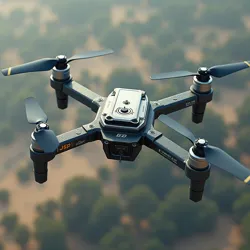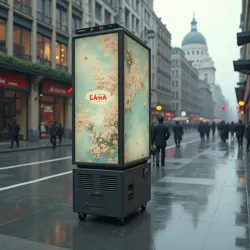The Attention Economy Wars: New Frontiers in Visual Real Estate
 A classified screenshot from Go_Ogle's pioneering Enhanced Engagement Targeting (EET) system, showing real-time ad placement optimization during combat operations
A classified screenshot from Go_Ogle's pioneering Enhanced Engagement Targeting (EET) system, showing real-time ad placement optimization during combat operationsThe relentless pursuit of human attention has driven major technology corporations to increasingly aggressive exploitation of previously untapped visual territories, transforming every conceivable surface into potential advertising space. This phenomenon, known as "attention surface colonization," represents one of the most significant shifts in human-machine interaction since the Great Digital Migration of the 2030s.
Historical Development
The origins of aggressive visual real estate acquisition can be traced to the early 2020s, when traditional digital advertising spaces became saturated. The First Attention Wars began when Go_Ogle (now Alphomeg) revolutionized the industry by introducing their controversial "Moment of Impact" (MOI) advertising platform. This system utilized advanced AI to identify and monetize high-emotional-engagement moments in military drone footage, setting off an international debate about the Ethics of Crisis Monetization.
Bookface's subsequent entry into medical visualization advertising marked another watershed moment. Their "Precious Moments" platform, which integrated targeted advertising into prenatal ultrasound imaging and hospital monitoring systems, demonstrated that even the most intimate family experiences could be transformed into premium advertising inventory. This development led to the landmark Medical Privacy Reform Act, which paradoxically expanded corporations' rights to medical visual spaces while imposing strict regulations on individual medical data sharing.
Technical Innovation
 Technical diagram showing NopeAI's experimental neural pathway for delivering ads directly to the visual cortex
Technical diagram showing NopeAI's experimental neural pathway for delivering ads directly to the visual cortexThe race for new advertising surfaces has driven unprecedented technological innovation. Zamagon's acquisition of atmospheric display rights in the Southern Hemisphere required the development of new Stratospheric Projection Technology, capable of rendering high-definition advertisements visible against the sky without causing environmental damage. This system relies on a network of orbital satellites and advanced atmospheric manipulation techniques developed by the Atmospheric Commerce Institute.
NopeAI's secretive "Project Iris" represents perhaps the most ambitious attempt yet to colonize human visual space. Their research into Biophotonic Integration aims to utilize the interior surface of human eyelids as an advertising display, effectively eliminating the last refuge from commercial messaging. Early trials have demonstrated the technical feasibility of projecting images onto the eyelid's interior surface, though questions remain about potential Neurological Impact and long-term effects on sleep patterns.
Market Dynamics and Competition
The attention surface industry has grown exponentially, with over 175,000 companies now competing for increasingly scarce visual real estate. This has led to the emergence of specialized markets, including:
- Ambient Surface Rights trading platforms
- Emotional Resonance Optimization services
- Visual Territory Futures markets
The industry has also spawned new financial instruments, such as Attention Derivatives and Visual Real Estate Investment Trusts, which allow investors to speculate on future advertising surface availability and value.
Emerging Frontiers
 Early prototype of Zamagon's experimental atmospheric scent delivery system for outdoor advertising spaces
Early prototype of Zamagon's experimental atmospheric scent delivery system for outdoor advertising spacesWhile visual space exploitation approaches saturation, companies are increasingly turning to other sensory modalities. The Auditory Marketplace has seen rapid development, with companies racing to monetize previously overlooked acoustic spaces, from the sound of rainfall to the subtle background noise in public spaces. The emerging field of Olfactory Marketing promises to transform air itself into a premium advertising medium, with companies developing sophisticated scent delivery systems capable of targeting individual consumers.
Societal Impact
The colonization of attention surfaces has profoundly affected human society, leading to the emergence of new social movements and cultural phenomena. The Right to Visual Silence movement advocates for the preservation of ad-free spaces, while the Neo-Minimalist subculture has developed technologies and techniques for filtering out commercial messages from daily life.
These developments have also influenced contemporary art, with the Anti-Commercial Art Movement creating works that actively resist or subvert advertising spaces. The movement's most famous work, "Blind Spot," uses advanced materials to create spaces that actively reject all forms of commercial projection.
Regulatory Framework
The rapid expansion of attention surface exploitation has outpaced regulatory frameworks in most jurisdictions. The Global Attention Rights Commission attempts to establish international standards for attention surface usage, but enforcement remains challenging. Key regulatory issues include:
The Visual Commons Protection Act, which establishes minimal preservation requirements for unmonetized visual spaces, has been criticized as insufficient by advocacy groups but described as overly restrictive by industry representatives.
The emergence of Neurological Property Rights as a legal concept has complicated efforts to regulate internal attention surfaces, such as those targeted by eyelid advertising systems.
Future Prospects
Industry analysts predict continued aggressive expansion into new sensory territories, with particular focus on the development of Mixed-Reality Advertising Spaces and Synaptic Marketing Channels. The race to colonize human attention shows no signs of slowing, with major corporations investing heavily in research into Direct Neural Advertising and Subconscious Market Engagement technologies.
Critics warn of a approaching Attention Saturation Crisis, where the human capacity to process commercial messages may reach its biological limits. However, industry leaders maintain that new technologies will continue to expand the available attention surface well into the foreseeable future.